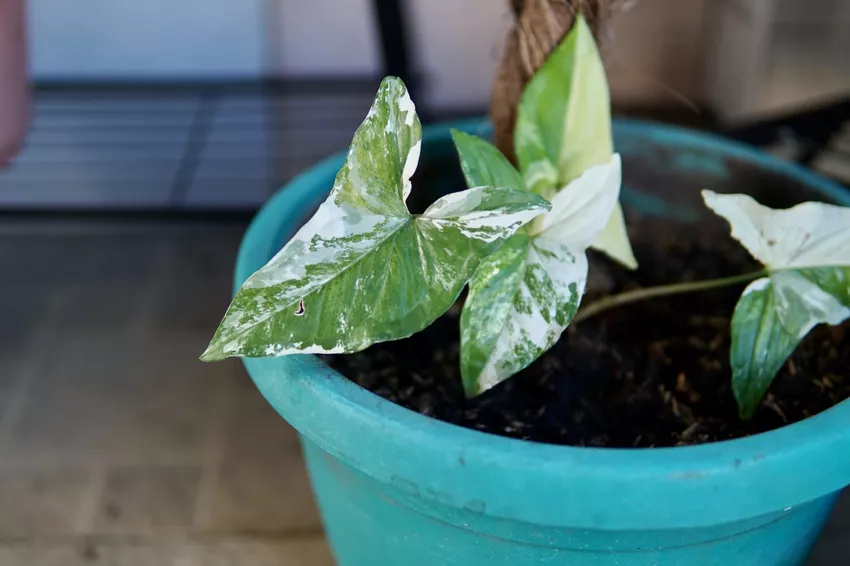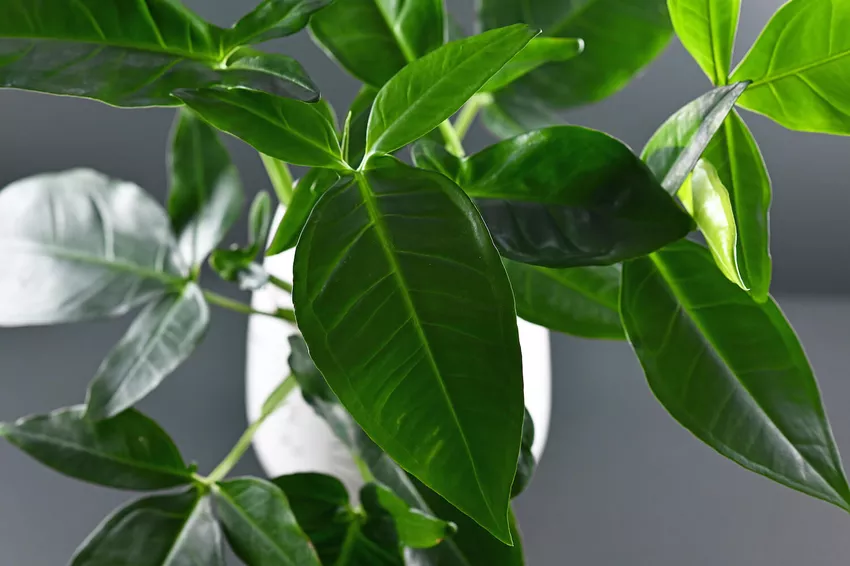The crimson mare is a real eye-catcher thanks to her climbing shoots. We present the most beautiful Syngonium types and varieties and give tips on care.

Purple Tutes are particularly special when it comes to their leaves. Their shape can change depending on how the plant grows and is cared for. One therefore also speaks of the changeable purple mare. Here you can find out how to properly care for the tropical plant and what varieties there are.
Syngonium: flower, origin and properties
The purple mare (Syngonium) is a genus of flowering plants within the aroid family (Aracea). It originally comes from Central and South America and grows there mainly in tropical and subtropical forests. The evergreen plant can grow up to 20 meters long and forms long shoots that either crawl across the ground or climb up trees. If the purple mare is kept as a houseplant, it can reach lengths of up to two meters. Depending on the species and variety, their foliage is green, reddish, white or multicolored. The shape of the leaves depends on the age of the shoots and the variety. Leaves of a different shape form on shoots in the adult stage. Syngonium can form oval or elliptical, arrow-shaped or even divided or deeply incised leaves. The species Syngonium podophyllum is the most common houseplant purple mare and is also known as the "variable purple mare".
The flowers of Syngonium are rather unspectacular and, like all arum plants, are flask-shaped. As a houseplant, the purple mare usually does not flower. Also typical of the aroid family, Syngonium is a poisonous plant.
Tip: Many aroids, including Syngonium, use thermogenesis to attract beetles for pollination. The inflorescence heats up by up to 12 °C in relation to the ambient temperature. In addition, the plant produces a strong, rather unappetizing smell for us, which is intended to mimic a food source for pollinators.

The most beautiful Syngonium species and varieties
The Syngonium species and cultivars differ primarily in terms of leaf colour, but growth characteristics can also differ from species to species. Care measures and location requirements are the same among the varieties. Only the light requirement is slightly higher for varieties with lighter leaves. We briefly present some beautiful species and varieties.
- Syngonium podophyllum 'Albo Variegata': This is a cultivar of the species Syngonium podophyllum , which differs from the actual species in its white variegated leaves. It is often called botanically incorrectly "Syngonium variegata" or "Syngonium albo variegata". Sometimes the color change on the sheet happens right in the middle.

- Syngonium podophyllum 'Arrow': The classic among the purple does has arrow-shaped leaves, which gave the variety its name. The leaves are green with white veins and are set on long stalks that may be climbing or hanging from a hanging basket.

- Syngonium podophyllum 'Pixie': This cultivar also has green-white leaves, but remains smaller than the actual species and reaches sizes of about 30 cm. It can grow compact or climb.

- Syngonium podophyllum 'Pink': As the name suggests, this purple cultivar develops pink or rose colored leaves. A similar cultivar is Syngonium podophyllum 'Pink Splash', the leaves of which are not entirely pink in color but appear as if they have been splattered with pink paint. Those who like delicate pink colored leaves will also like the variety Syngonium podophyllum 'Neon Robusta'.

- Syngonium podophyllum 'Trileaf Wonder': The name says it all with this variety too. The leaves are not arrow-shaped, but tripartite, with two small leaves emerging left and right at the base of the leaf, with one large leaf in the middle. The leaves are also shiny dark green.

- Syngonium wendlandii: This is not a variety, but its own SyngoniumSpecies. Its leaves are slightly longer than those of Syngonium podophyllum and are colored dark green. The median vein of the leaves stands out white against the rest of the leaf.

Risk of confusion between Syngonium (purple mare) and Philodendron (tree friend):
The two genera Syngonium and Philodendron look very similar and are therefore easy to confuse. That's no wonder, because they both belong to the aroid family. The most important distinguishing features can be found on the leaves:
- Leaf Shape: Syngonium has arrow-shaped leaves, Philodendron heart-shaped (depending on the variety it can however, it may be harder to tell the differences).
- Leaf veins: In Syngonium the leaf veins run into each other before reaching the leaf edge, in Philodendron they run individually up to the leaf edge.
Planting purple mare: location, soil and co .
The purple mare prefers a bright location with sufficient light. However, direct sun should be avoided. It is also important to base your light requirements on the color of the leaves of the respective variety. Crimson varieties with light-colored leaves or a high proportion of white coloration require more light in order to be able to provide themselves with sufficient energy through photosynthesis. Fully green strains have more chlorophyll, so they can thrive in a less bright area.
The temperature should be between 15 and 20 °C for Syngonium and should never drop below 15 °C. Even if it gets warmer, that's not ideal for the purple mare.
In this case, care should be taken to ensure that the humidity is sufficiently high. This must also be increased at ideal temperatures so that the purple mare grows nicely. Therefore, spray the plant regularly with lime-free water.

The purple mare makes no special demands on the substrate. However, high permeability is important to prevent waterlogging. To ensure water drainage, place a drainage layer of potsherds, stones or expanded clay on the bottom of the pot. Then plant the purple mare in good quality soil,such as our Plantura organic universal soil. Since Syngonium prefers a slightly acidic environment, our soil with a pH value of 6.1 to 6.9 is ideal. The contained clay minerals store the water well and release it again when it is dry. The production from natural raw materials and without peat protects the environment. For even better permeability, 30% crushed expanded clay or pine bark can also be mixed in.
The purple mare should be repotted into fresh soil about every 2 to 3 years at the beginning of spring. Choose a pot that is slightly larger in diameter than the old one. This gives the roots more space to develop, which also supports above-ground growth.
Syngonium care: The most important measures
The Syngonium care is not particularly difficult, the plant only has a few demands on the irrigation water.

Casting
Water the purple mare with lime-free water about once a week. The water temperature should be room temperature, ideally just use rainwater. Never let the root ball dry out completely, but water when the substrate surface is no longer damp. You should remove any water that has run off the saucer so that the crimson mare doesn't get wet feet.
In winter you can water less, since the crimson mare also grows more slowly in the cold season due to the lack of light. However, the substrate must not dry out completely.
Fertilize
Fertilize only during the main growth period from spring to autumn. You can use a liquid green plant fertilizer for the purple mare, such as our Plantura organic indoor and green plant fertilizer, which is perfectly tailored to the needs of ornamental foliage plants. Microorganisms are also included in the fertilizer to promote root growth. Our fertilizer is produced in a resource-saving manner and is based on natural ingredients. Use the fertilizer at half the concentration every three weeks or so.
Cut
The purple mare tolerates pruning well and can be shortened in spring when the shoots have become too long. Gloves should be worn when doing this, as Syngonium is poisonous. Simply cut off the shoots at the desired length with a sharp knife. You can then use the cut shoots to create new purple flowerspull.
Syngonium also forms aerial roots, which must never be cut off. You can instead place the rooted shoots in the pot on top of the substrate where the roots can grow into the soil.

Tip: If you cut a lot, you will achieve bushy growth and the juvenile leaf shape. In order to see the adult, changed leaf shape and long shoots, pruning should be done only rarely or not at all.
Propagating Syngonium
To propagate Syngonium, you can take cuttings from he althy, larger plants. The best time to take cuttings is spring or the first months of summer. Use a knife to cut off shoots about 10 cm long below a thickened spot on the shoot, the leaf node. Roots are usually created here, which can then sprout afterwards. Remove the bottom leaves and put the cuttings in the growing medium. For example, our Plantura organic herb and seed soil, which is specially produced for the cultivation of young plants, is suitable for this. Due to their low nutrient content, the plants are encouraged to develop more and stronger roots. Our organic soil consists of natural raw materials and contains no peat, which makes it a particularly climate-friendly soil.
After planting, place the small Syngonium cuttings in a bright spot with temperatures between 22 and 25 °C. Also put a plastic bag over the pots to increase humidity. Rooting should begin after four to eight weeks. Then you can repot your Syngonium into a more nutrient-rich soil.

Is the purple mare poisonous?
As is typical for the arum family, Syngonium is poisonous. Pets in particular should not eat the leaves. Therefore, place the plant in a safe place and wear gloves when repotting and pruning. The escaping juice should not touch the skin or eyes as it can cause itching and burning reactions.
Efeutute is also a climbing foliage plant that is quite easy to keep. In our article we give care tips for ivy.